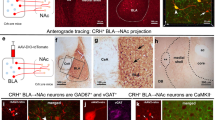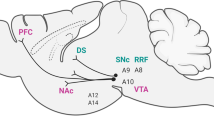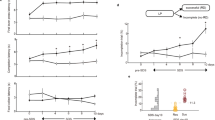Abstract
Stressors motivate an array of adaptive responses ranging from ‘fight or flight’ to an internal urgency signal facilitating long-term goals1. However, traumatic or chronic uncontrollable stress promotes the onset of major depressive disorder, in which acute stressors lose their motivational properties and are perceived as insurmountable impediments2. Consequently, stress-induced depression is a debilitating human condition characterized by an affective shift from engagement of the environment to withdrawal3. An emerging neurobiological substrate of depression and associated pathology is the nucleus accumbens, a region with the capacity to mediate a diverse range of stress responses by interfacing limbic, cognitive and motor circuitry4. Here we report that corticotropin-releasing factor (CRF), a neuropeptide released in response to acute stressors5 and other arousing environmental stimuli6, acts in the nucleus accumbens of naive mice to increase dopamine release through coactivation of the receptors CRFR1 and CRFR2. Remarkably, severe-stress exposure completely abolished this effect without recovery for at least 90 days. This loss of CRF’s capacity to regulate dopamine release in the nucleus accumbens is accompanied by a switch in the reaction to CRF from appetitive to aversive, indicating a diametric change in the emotional response to acute stressors. Thus, the current findings offer a biological substrate for the switch in affect which is central to stress-induced depressive disorders.
This is a preview of subscription content, access via your institution
Access options
Subscribe to this journal
Receive 51 print issues and online access
$199.00 per year
only $3.90 per issue
Buy this article
- Purchase on Springer Link
- Instant access to full article PDF
Prices may be subject to local taxes which are calculated during checkout




Similar content being viewed by others
Change history
17 October 2012
The spelling of an author name (J.R.S.) was corrected.
References
Korte, S. M., Koolhaas, J. M., Wingfield, J. C. & McEwen, B. S. The Darwinian concept of stress: benefits of allostasis and costs of allostatic load and the trade-offs in health and disease. Neurosci. Biobehav. Rev. 29, 3–38 (2005)
Beck, A. T. The evolution of the cognitive model of depression and its neurobiological correlates. Am. J. Psychiatry 165, 969–977 (2008)
Clark, D. A. & Beck, A. T. Cognitive theory and therapy of anxiety and depression: convergence with neurobiological findings. Trends Cogn. Sci. 14, 418–424 (2010)
Nestler, E. J. et al. Neurobiology of depression. Neuron 34, 13–25 (2002)
Wang, B. et al. Cocaine experience establishes control of midbrain glutamate and dopamine by corticotropin-releasing factor: a role in stress-induced relapse to drug seeking. J. Neurosci. 25, 5389–5396 (2005)
Merali, Z., McIntosh, J. & Anisman, H. Anticipatory cues differentially provoke in vivo peptidergic and monoaminergic release at the medial prefrontal cortex. Neuropsychopharmacology 29, 1409–1418 (2004)
Gallagher, J. P., Orozco-Cabal, L. F., Liu, J. & Shinnick-Gallagher, P. Synaptic physiology of central CRH system. Eur. J. Pharmacol. 583, 215–225 (2008)
Steckler, T. & Holsboer, F. Corticotropin-releasing hormone receptor subtypes and emotion. Biol. Psychiatry 46, 1480–1508 (1999)
Peciña, S., Schulkin, J. & Berridge, K. C. Nucleus accumbens corticotropin-releasing factor increases cue-triggered motivation for sucrose reward: paradoxical positive incentive effects in stress? BMC Biol. 4, 8 (2006)
Lim, M. M. et al. CRF receptors in the nucleus accumbens modulate partner preference in prairie voles. Horm. Behav. 51, 508–515 (2007)
Aragona, B. J. et al. Nucleus accumbens dopamine differentially mediates the formation and maintenance of monogamous pair bonds. Nature Neurosci. 9, 133–139 (2006)
Lex, A. & Hauber, W. Dopamine D1 and D2 receptors in the nucleus accumbens core and shell mediate Pavlovian-instrumental transfer. Learn. Mem. 15, 483–491 (2008)
Waselus, M., Nazzaro, C., Valentino, R. J. & Van Bockstaele, E. J. Stress-induced redistribution of corticotropin-releasing factor receptor subtypes in the dorsal raphe nucleus. Biol. Psychiatry 66, 76–83 (2009)
Timpl, P. et al. Impaired stress response and reduced anxiety in mice lacking a functional corticotropin-releasing hormone receptor 1. Nature Genet. 19, 162–166 (1998)
Bale, T. L. et al. Mice deficient for corticotropin-releasing hormone receptor-2 display anxiety-like behaviour and are hypersensitive to stress. Nature Genet. 24, 410–414 (2000)
Cador, M., Ahmed, S. H., Koob, G. F., Le Moal, M. & Stinus, L. Corticotropin-releasing factor induces a place aversion independent of its neuroendocrine role. Brain Res. 597, 304–309 (1992)
Oldfield, E. H. et al. Active clearance of corticotropin-releasing factor from the cerebrospinal fluid. Neuroendocrinology 40, 84–87 (1985)
Fink, J. S. & Smith, G. P. Mesolimbic and mesocortical dopaminergic neurons are necessary for normal exploratory behavior in rats. Neurosci. Lett. 17, 61–65 (1980)
Bale, T. L. Stress sensitivity and the development of affective disorders. Horm. Behav. 50, 529–533 (2006)
Bruchas, M. R. et al. Stress-induced p38 mitogen-activated protein kinase activation mediates κ-opioid-dependent dysphoria. J. Neurosci. 27, 11614–11623 (2007)
Coryell, W. et al. The time course of nonchronic major depressive disorder. Uniformity across episodes and samples. National Institute of Mental Health Collaborative Program on the Psychobiology of Depression–Clinical Studies. Arch. Gen. Psychiatry 51, 405–410 (1994)
Torres, G., Horowitz, J. M., Laflamme, N. & Rivest, S. Fluoxetine induces the transcription of genes encoding c-fos, corticotropin-releasing factor and its type 1 receptor in rat brain. Neuroscience 87, 463–477 (1998)
Bruchas, M. R. & Chavkin, C. Kinase cascades and ligand-directed signaling at the kappa opioid receptor. Psychopharmacology (Berl.) 210, 137–147 (2010)
Iredale, P. A. & Duman, R. S. Glucocorticoid regulation of corticotropin-releasing factor1 receptor expression in pituitary-derived AtT-20 cells. Mol. Pharmacol. 51, 794–799 (1997)
Cryan, J. F. & Mombereau, C. In search of a depressed mouse: utility of models for studying depression-related behavior in genetically modified mice. Mol. Psychiatry 9, 326–357 (2004)
Kessler, R. C. et al. Lifetime prevalence and age-of-onset distributions of DSM-IV disorders in the National Comorbidity Survey Replication. Arch. Gen. Psychiatry 62, 593–602 (2005); erratum. 62, 768 (2005)
Gelenberg, A. J. Depression symptomatology and neurobiology. J. Clin. Psychiatry 71, e02 (2010)
Refojo, D. et al. Glutamatergic and dopaminergic neurons mediate anxiogenic and anxiolytic effects of CRHR1. Science 333, 1903–1907 (2011)
Chaki, S. et al. Anxiolytic- and antidepressant-like profile of a new CRF1 receptor antagonist, R278995/CRA0450. Eur. J. Pharmacol. 485, 145–158 (2004)
Reyes, B. A., Valentino, R. J. & Van Bockstaele, E. J. Stress-induced intracellular trafficking of corticotropin-releasing factor receptors in rat locus coeruleus neurons. Endocrinology 149, 122–130 (2008)
van Bockstaele, E. J., Sesack, S. R. & Pickel, V. M. Dynorphin-immunoreactive terminals in the rat nucleus accumbens: cellular sites for modulation of target neurons and interactions with catecholamine afferents. J. Comp. Neurol. 341, 1–15 (1994)
Reyes, B. A., Fox, K., Valentino, R. J. & Van Bockstaele, E. J. Agonist-induced internalization of corticotropin-releasing factor receptors in noradrenergic neurons of the rat locus coeruleus. Eur. J. Neurosci. 23, 2991–2998 (2006)
Peters, A., Palay, S. L. & Webster, H. D. The Fine Structure of the Nervous System (Oxford Univ. Press, 1991)
Peters, A. & Palay, S. L. The morphology of synapses. J. Neurocytol. 25, 687–700 (1996)
Bruchas, M. R., Land, B. B., Lemos, J. C. & Chavkin, C. CRF1-R activation of the dynorphin/kappa opioid system in the mouse basolateral amygdala mediates anxiety-like behavior. PLoS ONE 4, e8528 (2009)
Acknowledgements
This work was supported by National Institutes of Health grants F31-MH086269 (J.C.L.), F32-DA026273 (M.J.W.), R01-DA009082 (E.J.V.B.), R01-DA030074 (C.C.), R01-MH079292 and R01-DA016782 (P.E.M.P.), the National Science Foundation (N.G.H.) and NARSAD (P.E.M.P.). We thank C. Zietz, M. Miyatake and P. Groblewski for assisting with histological verification of cannula placement, H. Gill for help with data analysis, D. Messinger for breeding and genotyping mice and N. Stella for use of a microscope. We thank M. Darvas and R. Palmiter for providing Thfs/fs;DbhTh/+ mice. We thank R. Sapolsky, J. Day, S. Sesack, M. Soden, C. Walker and E. Horne for useful suggestions and insights.
Author information
Authors and Affiliations
Contributions
Author Contributions J.C.L. performed immunohistochemistry. J.C.L. and N.G.H. carried out fast-scan cyclic-voltammetry experiments. J.C.L., M.J.W. and J.S.S. performed the behavioural experiments. B.A.S.R. and E.J.V.B. provided transmission electron microscopy data. J.C.L., M.J.W., C.C. and P.E.M.P. developed the conceptual and experimental framework, and J.C.L. and P.E.M.P. wrote the paper.
Corresponding author
Ethics declarations
Competing interests
The authors declare no competing financial interests.
Supplementary information
Supplementary Information
This file contains Supplementary Figures 1-15, Supplementary Table 1, a Supplementary Discussion and additional references. (PDF 1880 kb)
Rights and permissions
About this article
Cite this article
Lemos, J., Wanat, M., Smith, J. et al. Severe stress switches CRF action in the nucleus accumbens from appetitive to aversive. Nature 490, 402–406 (2012). https://doi.org/10.1038/nature11436
Received:
Accepted:
Published:
Issue Date:
DOI: https://doi.org/10.1038/nature11436
This article is cited by
-
CRF regulates pain sensation by enhancement of corticoaccumbal excitatory synaptic transmission
Molecular Psychiatry (2024)
-
Chemogenetic activation of corticotropin-releasing factor-expressing neurons in the anterior bed nucleus of the stria terminalis reduces effortful motivation behaviors
Neuropsychopharmacology (2024)
-
Chronically dysregulated corticosterone impairs dopaminergic transmission in the dorsomedial striatum by sex-divergent mechanisms
Neuropsychopharmacology (2023)
-
Stress-induced plasticity of a CRH/GABA projection disrupts reward behaviors in mice
Nature Communications (2023)
-
The Nucleus Accumbens CRH–CRHR1 System Mediates Early-Life Stress-Induced Sleep Disturbance and Dendritic Atrophy in the Adult Mouse
Neuroscience Bulletin (2023)
Comments
By submitting a comment you agree to abide by our Terms and Community Guidelines. If you find something abusive or that does not comply with our terms or guidelines please flag it as inappropriate.



